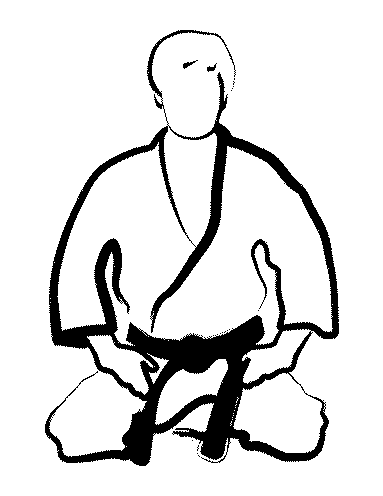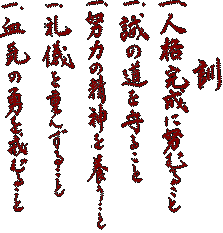Shotokan Karate Traditional Protocol
The protocol we follow during our class is an expression of our interest in upholding Japanese tradition in our karate training.
- Before entering the dojo, we take our shoes off. Upon enteri
ng, one must be ready for class (thus, for example, the belt must be put on prior to entering the dojo). The dojo is not a locker room.

- Any time we enter or leave the dojo, we bow toward shomen, as a sign of respect for everything that the dojo means to us. Shomen is the front wall of the room; sho means "true" and men means "face". Bowing is a Japanese custom for displaying respect, humility, and lack of arrogance. It is not a matter of "bowing down" to a superior; as you notice, black belts bow to lower belts and vice versa.
- Considering that we train barefoot, the floor of the dojo must be cleaned prior to class. This is a task fulfilled by lower ranked karateka and is done with a mop, before class.
- When class begins, we line up shoulder to shoulder, in rank order, with higher ranks to the right, lower ranks to the left. One of the senior students will then issue commands:
- Seiza ("kneel down"): done in rank order, starting with the higher ranks first.
- Mokusoh ("meditate"): we take one minute to empty our minds and prepare for maximum concentration during class. Meditation should be done with eyes closed, body relaxed, and exclusive concentration on your breathing.
- Mokusoh yame ("stop meditating"): gently return the focus from your inner self back to the environment you are in.
- Shomen ni rei ("bow to shomen"): we bow as a sign of respect and thanks to the founder of Shotokan and the ancestors.
- Sensei ni rei ("bow to sensei"): the entire class bows to the teacher. If sensei is not present, the command will be senpai ni rei, thus bowing to the leader of that day's class.
- Senpai ni rei ("bow to senpai"): we all symbolically bow to each other by bowing forward. This is a way of giving thanks to everyone for being present and helping us learn karate.
- When a karateka arrives late, he/she warms up and stretches prior to entering the dojo. Then the karateka comes inside, bows, and goes through seiza, mokusoh, and bowing to shomen. At this point, wait for sensei's or senpai's permission to join the class.
- Sensei or senpai will then instruct us to stand up and form a staggered line, for warm-up. We all stand up, in order of rank from highest to lowest; it is a sign of disrespect to stand up before the person to your left. Next we stretch and warm up, after which we start the class.
- During class, all karateka concentrate on what is being taught and on practice, avoiding distractions. One should not leave the class without sensei's or senpai's acknowledgement; it is perfectly OK to ask for a break if something is wrong (you're injured, etc.). It is also OK to ask questions and clarifications that are of general interest to your fellow karateka (individual questions can be asked after class). Unless absolutely necessary, do not interrupt class during an exercise -- wait until sensei or senpai gives students a brief break in between sets.
- When class is over, sensei or senpai will ask us to line up. Then we go through seiza and mokusoh. Then we recite the dojo kun ("rules of the dojo"). These are a set of five rules that were passed down from the masters of Okinawan karate, and are an affirmation of things we believe in and must keep in mind at all time:
- Seek perfection of character
- Be faithful
- Endeavor
- Respect others
- Refrain from violent behavior
- It is an approximate translation of the following Japanese rules:
- After the dojo kun, we do the three bows: to shomen, sensei and senpai. After that we stand up, in order of rank, and bow once again.
Class is over.
